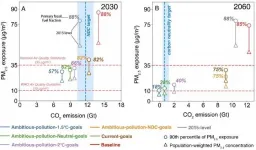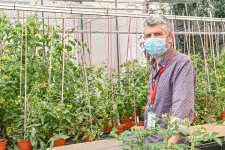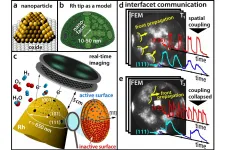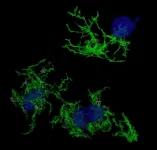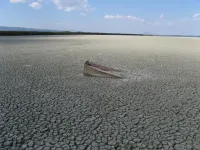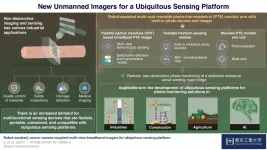Telling up from down: How marine flatworms learn to sense gravity
Zoologists explore the mechanism and development of gravity-sensing ability in marine acoel flatworms
2021-05-21
(Press-News.org) All living organisms are equipped with sensory organs to detect changes in their surrounding environment. It may not immediately strike us as obvious but, similar to how we can sense heat, cold, light, and darkness, we are also extremely adept at sensing gravity. In our case, it is our inner ear that does this job, helping us maintain balance, posture, and orientation in space. But, what about other organisms, for instance invertebrates that lack a backbone?
The gravity sensing organ in some aquatic invertebrates, known as a "statocyst," is, in fact, rather fascinating. The statocyst is essentially a fluid-filled sac with sensory cells lining its inner wall and a small, mineralized mass called "statolith" contained inside. During any body movement, the statolith moves and consequently comes in contact with sensory cells in the inner wall, deflecting them. The deflections, in turn, activate the neurons (nerve cells), which then relay signals to the brain about changes in body orientation.
However, exactly how the sensory cells stimulate the neurons is not particularly clear for acoel flatworms--soft-bodied, marine animals with a simple anatomy, which represent one of the earliest extant life forms with bilateral (left-right) symmetry. What zoologists know so far, based on the finding that juvenile acoel flatworms occasionally fail to sense gravity, is that the ability is acquired sometime after hatching from the eggs.
In a new study published in Zoomorphology, scientists from Okayama University, Japan led by Prof. Motonori Ando have now taken a stab at understanding these curious creatures better. But what exactly is so attractive about acoel flatworms? Prof. Ando explains, "Understanding the stimulus response mechanism of Acoela can uncover a fundamental biological control mechanism that dates back to the origin of bilaterian animals, including humans. These organisms, therefore, are key to unravelling the process of evolution."
For their study, the scientists used an acoel species called Praesagittifera naikaiensis or P. naikaiensis that is endemic to the Seto Island Sea coasts at Okayama. "The mysterious body plan of P. naikaiensis could be key to connecting Okayama and the world's natural environment," says Prof. Ando.
To examine the relationship between the statocyst and nervous system of P. naikaiensis, the scientists had to make them both visible, a task usually accomplished by a "marker" or a "label." However, due to a lack of any suitable label for the statocyst, they adopted a different strategy in which they labeled instead the basal lamina, the layer on which the sensory cells sit. As for the nervous system, they labeled the nerve terminals using a well-known marker. Finally, they studied the specimen using confocal microscopy, a technique in which light is focused on to a defined spot at a specific depth to stimulate only local markers.
The results were illuminating. The scientists found that the acoel flatworm developed a gravity-sensing ability within 0 to 7 days after hatching, with the statolith forming after hatching. The statocyst comprised longitudinal and transverse nerve cords, forming what is called a "commissural brain" and a "statocyst-associated-commissure" (stc) characterized by transverse fibers. They hypothesized that a gravity-sensing ability developed when: 1) the statolith acquired a sufficient concentration of calcium salts, 2) stc functioned as the signal-relaying neurons, and 3) the sensory cells were present outside the sac and stimulated indirectly by the statolith through the basal lamina and stc.
Inspired by these findings, Prof. Ando has envisioned future research directions and even practical applications of their study. "It has been reported that closely related species of this organism inhabit the North Sea coast, the Mediterranean coast, and the east coast of North America. Since there is great interest about the commonality of their habitats, we can extend our research to a more global level, using these animals as a novel bioassay system for the environment they live in, especially in the face of the accelerated pace of climate change and anthropogenic habitat degradation. Furthermore, acoel flatworms could be an excellent biological model for studying diseases caused in humans due to abnormalities of sensory hair cells," says an excited Prof. Ando.
It seems modern science is just warming up to the myriad mysteries of this minute worm!
INFORMATION:
[Attachments] See images for this press release:
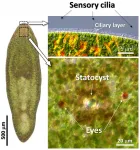
ELSE PRESS RELEASES FROM THIS DATE:
2021-05-21
[Highlights]
- Integrated cyber attack analysis platform "NIRVANA Kai" newly supports IPv6 and enhances its functions.
- Observation of IPv6 communications, collection of IPv6-related alerts, and real-time visualization of IPv6 networks.
- Expected to simplify security operations in IPv6 networks.
[Abstract]
The Cybersecurity Laboratory of the National Institute of Information and Communications Technology (NICT, President: TOKUDA Hideyuki, Ph.D.) has enhanced its cyber attack integrated analysis platform "NIRVANA Kai" to support the Internet Protocol version ...
2021-05-21
China's clean air policies have substantially reduced PM2.5 air pollution in recent years. Yet >99% of Chinese population is still exposed to PM2.5 concentrations in excess of the World Health Organization (WHO) Air Quality Guidelines of 10 μg/m3. Climate actions targeting to reduce fossil fuel consumption also have substantial air quality benefits. The announcement of ambitious climate commitment to achieve carbon neutrality by 2060 may fuel the power to long-term air quality improvement in China.
Combining Global/China's climate mitigation pathways (i.e. global 2°C- and 1.5°C-pathways, NDC pledges, and carbon neutrality goals) and local clean ...
2021-05-21
An international research group involving the Institute of Molecular and Cellular Biology of Plants (IBMCP), a joint centre of the Universitat Politècnica de València (UPV) and the Spanish National Research Council (CSIC), has discovered that a genetic mechanism, called CHLORAD, which is involved in the ageing of plant leaves, also plays a decisive role in the tomato ripening process. Thus, tomatoes with an activated CHLORAD system turn red more quickly, and accumulate more lycopene, a compound beneficial to health. The results, which have been published in the latest issue of the journal Nature Plants, will lead to better quality tomatoes.
The ripening of most fleshy fruits gives them attractive colours and smells, which is a trick of the plant to spread its seeds ...
2021-05-21
Most of commercial chemicals are produced using catalysts. Usually, these catalysts consist of tiny metal nanoparticles that are placed on an oxidic support. Similar to a cut diamond, whose surface consists of different facets oriented in different directions, a catalytic nanoparticle also possesses crystallographically different facets - and these facets can have different chemical properties.
Until now, these differences have often remained unconsidered in catalysis research because it is very difficult to simultaneously obtain information about the chemical reaction itself and about the surface structure of the catalyst. At TU Wien (Vienna), this has now been achieved by combining different microscopic methods: with ...
2021-05-21
SINGAPORE, 21 May 2021 - Alzheimer's Disease is the most common form of dementia and is characterised by the build-up of amyloid plaques in the brain. Microglia, the immune sentinels of the brain, are not only responsible for eliminating foreign invaders, but also maintaining brain homeostasis by clearing toxic waste such as the amyloid plaques.
However, the role of microglia in Alzheimer's Disease and its relationship to amyloid plaque accumulation remain unclear. Now, a team of scientists from Duke-NUS Medical School and Monash University have found the gene expression signatures underlying microglia associated ...
2021-05-21
More than 100 kg of highly toxic uranium (U) and plutonium (Pu) was dispersed in the form of tiny 'hot' radioactive particles after the British detonated nine atomic bombs in remote areas of South Australia, including Maralinga.
Scientists say that these radioactive particles persist in soils to this day, more than 60 years after the detonations. Previously, we had limited understanding of how Pu was released from these "hot" particles into the environment for uptake by wildlife around Maralinga.
But now, a new study published today in Scientific Reports and led by Monash University researchers warns that the particles are actually more ...
2021-05-21
A new study shows that the current rate of biodiversity decline in freshwater ecosystems outcompetes that at the end-Cretaceous extinction that killed the dinosaurs: damage now being done in decades to centuries may take millions of years to undo.
The current biodiversity crisis, often called the 6th mass extinction, is one of the critical challenges we face in the 21st century. Numerous species are threatened with extinction, mostly as a direct or indirect consequence of human impact. Habitat destruction, climate change, overexploitation, pollution and invasive species are among the main causes for Earth's biota to decline rapidly.
To investigate the tempo of extinction and predict recovery times, an international team of evolutionary biologists, paleontologists, geologists and modelers ...
2021-05-21
One of the key aspects of academic and industrial research today is non-destructive imaging, a technique in which an object or sample is imaged (using light) without causing any damage to it. Often, such imaging techniques are crucial to ensuring safety and quality of industrial products, subsequently leading to growing demands for high-performance imaging of objects with arbitrary structures and locations.
On one hand, there has been tremendous advancements in the scope of non-destructive imaging regarding the region of electromagnetic (EM) spectrum it can access, which now ranges from visible light to as far as millimeter waves! On the other, imaging devices have become flexible and wearable, enabling stereoscopic (3D) visualization ...
2021-05-21
Because individual atoms or molecules are 100 to 1000 times smaller than the wavelength of visible light, it is notoriously difficult to collect information about their dynamics, especially when they are embedded within larger structures.
In an effort to circumvent this limitation, researchers are engineering metallic nano-antennas that concentrate light into a tiny volume to dramatically enhance any signal coming from the same nanoscale region. Nano-antennas are the backbone of nanoplasmonics, a field that is profoundly impacting biosensing, photochemistry, solar energy harvesting, and photonics.
Now, researchers at EPFL led by Professor Christophe Galland at the School of Basic Sciences ...
2021-05-21
Research has shown that joining a gang is associated with increased criminal behavior. A new study examined whether the intermittent nature of gang membership affects offending. Researchers sought to determine whether the association with increased offending was a consistent attribute or, since people enter and exit and re-enter gangs, whether the intermittent nature of membership affected members' likelihood of offending. The study found that first-time membership was associated with increases in criminal behavior from when gang members were not in gangs, and that joining for a second ...
LAST 30 PRESS RELEASES:
[Press-News.org] Telling up from down: How marine flatworms learn to sense gravity
Zoologists explore the mechanism and development of gravity-sensing ability in marine acoel flatworms


